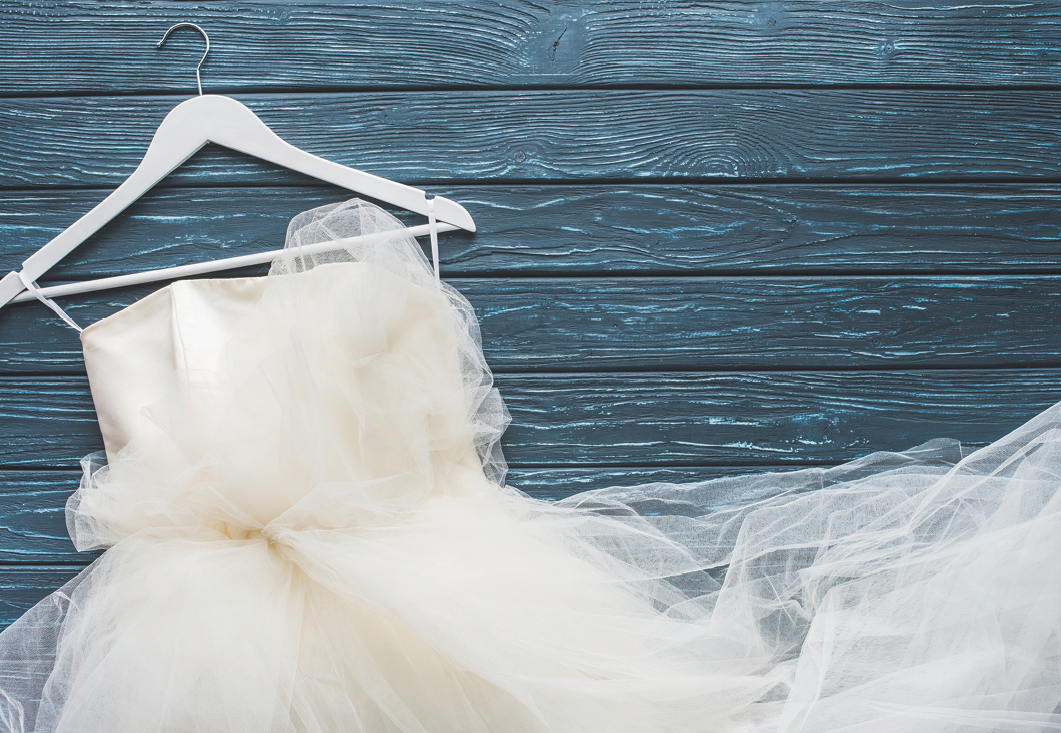3 ways to preserve your gown
or memories of it
Story by Julia Moore

Bridal gowns in Alaska are typically around $1,200. With this much invested, it’s important to weigh your options for what to do with it after your wedding. Here are some popular ideas explained by local experts, whether you want it to stay in the family, be donated to a good cause, or be used to make art.
Preserve it
Possibly the most common thing to do with a gown is to have it preserved. And if you plan to preserve your gown – regardless of whether or not you plan to keep it – the key is to get it cleaned right away. Throughout the night, you might work up a sweat from dancing or even spill a little champagne. “Do not delay, because it makes it harder to get those stains out,” says Orainda Beile, owner of Orainda’s Bridal Boutique. She warns that even though that champagne spill may be clear at the time, it will turn into a dark, gluey mess if left on the dress.
To keep the dress safe for years, you can talk to your favorite dry cleaner about preserving it in a box, or take a visit to the shop where you purchased the dress to see if they have a preservation service they use or would recommend. Plus, they’ll love to see photos of you in your dress. Many preservation companies will also professionally clean or even make minor repairs to the dress. “I have photos of my great grandmother’s wedding gown from 1901, and it was yellow like the end of a cigarette butt,” says Orainda. “They cleaned it, pressed it and preserved it. It’s absolutely stunning.”
Donate it
Alaska is home to many quality thrift shops, like the Salvation Army, that happily accept used wedding dresses, but there are other organizations looking for dresses like yours to help out the community. Angel Gowns of Alaska is a nonprofit that repurposes wedding dresses into “angel gowns” for babies who die in utero after 20 weeks gestation or who are stillborn. “It’s a very, very sad thing that these parents are going through, but it’s also a beautiful gift that the nurses can present the baby in this beautiful gown and have it look like an angel,” says Orainda. Anyone donating a dress, whether it’s their dress or a relative’s, can purchase a handkerchief or a small pillow made from the fabric, and the proceeds go back into Angel Gowns.
Or consider one of the national options, such as Brides Across America, that accept donated dresses to set up shopping events for military and first responder brides, and Wish Upon a Wedding, that helps couples where one or both partners suffer a terminal illness or have had life-altering circumstances.
Destroy it
It may seem like a cringe-worthy choice, at first, but many couples are actually destroying their wedding dresses in what are known as “trash the dress” photoshoots. Why? Joe Connolly with Chugach Peaks Photography sums it up: “Couples want to do something different, something big and beautiful and visually stunning.”
Joe takes couples to the top of mountains, in rivers, lakes, glacial pools, and more, for a trip that they will never forget. Tromping around the woods or on a mountaintop can coat a dress in dirt, but it’s well worth it. “They look back on it fondly, and they’re happy that they did it,” says Joe. “Whether they’re hiking up somewhere or flying somewhere, it’s kind of an adventure in and of itself.”
These “trash the dress” shoots, though, are usually a misnomer, since many times the dress can be fully cleaned, because these shoots usually just involve dirt or water, says Joe. If a couple really wants to trash the dress, they have to really go for it. “We had a couple a few years ago that basically had a mud fight at Bird Creek, the popular fishing spot off the Seward highway, that was very, very muddy during low tide,” remembers Joe. “They were completely covered in mud, like 100-percent covered in mud. That was a total trash-the-dress.”
So, if you’re after those breathtaking, panoramic mountain shots for your wedding portraits, your dress should be fine, and you’ll make amazing memories in the process. “Couples are getting something unique that they can look back on to remember their experience and their adventure,” explains Joe. “A lot of the places that we take people to have never seen footsteps in the history of time. If they do, they get very little traffic.”







